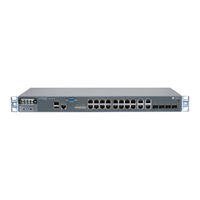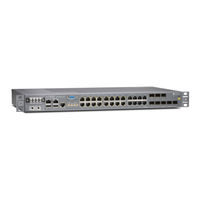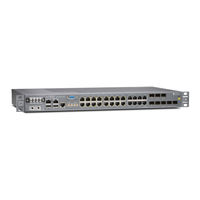Juniper ACX2100 Manuals
Manuals and User Guides for Juniper ACX2100. We have 6 Juniper ACX2100 manuals available for free PDF download: Configuration Manual, Hardware Manual, Quick Start Manual
Juniper ACX2100 Configuration Manual (3270 pages)
Junos OS; ACX Series Universal Access Router
Brand: Juniper
|
Category: Network Router
|
Size: 27.72 MB
Table of Contents
-
Overview59
-
-
Junos os62
-
Interfaces62
-
Junos Space63
-
-
-
-
-
-
Overview164
-
-
-
Protocol Support167
-
Packet Latency167
-
Cesopsn Options168
-
Show Commands168
-
-
Acronyms171
-
Ring Nodes171
-
Ring Node States171
-
Logical Ring172
-
FDB Flush172
-
Multiple Rings175
-
Node ID175
-
Ring ID175
-
-
-
Alarm Input216
-
Alarm Output217
-
-
-
IMA Version233
-
IMA Frame Length233
-
Transmit Clock233
-
IMA Clocking239
-
-
-
-
-
MIC with SFP264
-
-
-
Clock Sources283
-
-
Routers365
-
-
-
-
Events396
-
-
-
-
Filename409
-
-
-
-
-
Logged414
-
-
-
Are Logged416
-
-
-
-
-
Convergence467
-
-
Disabling MSTP475
-
-
Switched Network487
-
-
LLDP Overview489
-
-
-
Enabling IGMP505
-
Configuring IGMP506
-
Disabling IGMP508
-
Disabling IGMP529
-
-
-
-
Routers567
-
-
Interfaces575
-
-
-
-
Ipv6 Overview588
-
-
Header Structure589
-
-
Ipv6 Addressing589
-
Address Types590
-
Address Scope590
-
-
IS-IS Overview594
-
OSPF Overview600
-
-
-
-
-
-
Address716
-
Advertisement
Juniper ACX2100 Hardware Manual (172 pages)
Universal Access Router
Brand: Juniper
|
Category: Network Router
|
Size: 4.31 MB
Table of Contents
-
-
-
-
-
T1/E1 Ports33
-
Poe Ports35
-
-
-
-
Requirements47
-
-
-
-
Device71
-
-
-
-
Appendixes97
-
-
Router104
-
Fire Suppression106
-
Ramp Warning111
-
Devices115
-
Juniper ACX2100 Hardware Manual (190 pages)
Brand: Juniper
|
Category: Network Router
|
Size: 2.71 MB
Table of Contents
-
1 Overview
16 -
-
Advertisement
Juniper ACX2100 Quick Start Manual (30 pages)
Universal Metro Routers
Brand: Juniper
|
Category: Network Router
|
Size: 1.37 MB
Table of Contents
Juniper ACX2100 Quick Start Manual (30 pages)
Universal Metro Routers
Brand: Juniper
|
Category: Network Router
|
Size: 1.32 MB
Table of Contents
Juniper ACX2100 Quick Start Manual (26 pages)
Universal Access Routers
Brand: Juniper
|
Category: Network Router
|
Size: 0.75 MB
Table of Contents
-
Management12
-
Device12
-
Router22
-
Canada22
Advertisement





